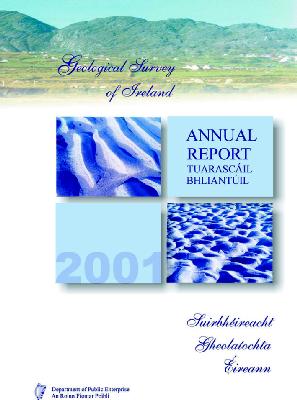| 2002 |

|
YEAR BOOK |
GEOLOGICAL SURVEY OF IRELAND
|
GSI – Firmly in the 21st Century
|

The Geological Survey of Ireland (GSI) Annual Report for 2001 highlighted some areas of important progress:
-
Work started on a document management
system, underpinned by a newly
established scanning service, and on
development of an integrated database
structure in Oracle.
-
The 1:100,000 bedrock map series
progressed sufficiently to ensure its
completion in 2003, and new fast-track
approaches were advanced in
Quaternary mapping, providing important
information for resource and land
use planning
-
90% of deeper water areas was surveyed
in the National Seabed Survey and a
data management system established to
ensure the resulting information is
easily available for fisheries, energy and
engineering projects.
-
Work on four county (Kilkenny,
Monaghan, South Cork and Tipperary
North) Groundwater Protection
Schemes was either fully or almost fully
completed and the data provided to the
relevant local authorities as a decision-supporting
system in land use planning.
1. To provide easily accessible and accurate geological information,
2. To support sustainable development, environmental protection and the National Development Plan,
3. To map Ireland’s earth resources,
4. To promote public understanding of the role of GSI and geology in Irish society,
5. To provide a stimulating, motivating and rewarding work environment for GSI staff.
Information Management Programme
Information Management has become the top priority for GSI. At its heart is the management of how we acquire, verify, manipulate, interpret and provide information. The Earth Resource Information Warehouse (ERIW), intended to deliver integrated database and geographic information systems (GIS), which started in 2000, was designed to ensure GSI could provide this service electronically and effectively. Significant progress, stimulated by moneys from the Government’s Information Society Fund, has been made. In particular:
-
A digital document management system
(DMS) has been designed and installed.
-
A bureau scanning service had at end
2001 captured about 40,000 records,
including a significant batch of nineteenth
century six-inch field sheets.
-
The Geotechnical Database has been
developed to allow internal web
browser access to data through the provision
of an embedded GIS input and
editing module.
-
A pilot B2C (Business to Customer) site
was initiated. This is scheduled to be
fully operational during 2002.
-
Work started on developing an integrated
database structure in Oracle. This
project, developed in collaboration with
the British Geological Survey, will
revolutionise the storage and manipulation
of digital data in GSI.
Importantly, it will form the foundation
for web-enabled data delivery systems
to customers.
-
Web-enabled information delivery
systems, the ultimate goal of the ERIW
initiative, are being developed and funding is being sought to speed up this
element.
National Seabed Survey
This €27 million project will progress through its third survey season in 2002. By the end of this season, coverage of Zone 3, the deeper water area of the Irish seabed where water depths exceed 200m, will be complete. The Survey is producing several datasets – including multibeam bathymetry, multibeam backscatter, sub-bottom profiler, magnetic and gravity data, and sea-water temperature and salinity profiles. 2002 sees the beginning of surveying in Zone 2 (200m–50m water depth), and data in even shallower waters are also being gathered during transits to deeper waters. 2002 will also see the start of the deep seismic and ground truthing programmes. The Survey is originating vast amounts of data and a 3 tera-byte mass data storage and management system has been established in order to ensure that information can be provided efficiently to customers. All of this information is now available in both paper and digital formats.
Despite there being no obvious precedent for this type of project in size and scope anywhere in the world, and despite it conforming to the highest international standards, the Survey is ahead of schedule. It remains true to a primary objective, that of widening the national skill pool in marine science, by facilitating various ancillary projects – including the collection of weather data for Met Éireann and cetacean observations for the Irish Whale & Dolphin Group. It continues to encourage inter-departmental co-operation and facilitates international technology transfer arrangements, and is now a worthy model for future large-scale government projects. The overall dataset is the seed for Joint Industry Programmes – e.g. a strategic partnership has been developed with Bord Iascaigh Mhara and the fisheries industry, and holds potential for EU 6th Framework Programme Integrated Projects and Public Private Partnerships.
The Annual Report and Strategic Vision can be seen at the GSI web site. A limited number of copies are available from Theresa Williams – Tel: 01 604 1481.
Contacts:
IMP – Koen Verbruggen 01 604 1425;
E-mail [email protected];
Seabed Survey – Enda Gallagher
01 604 1381
E-mail [email protected] ; Web: http://www.gsi.ie